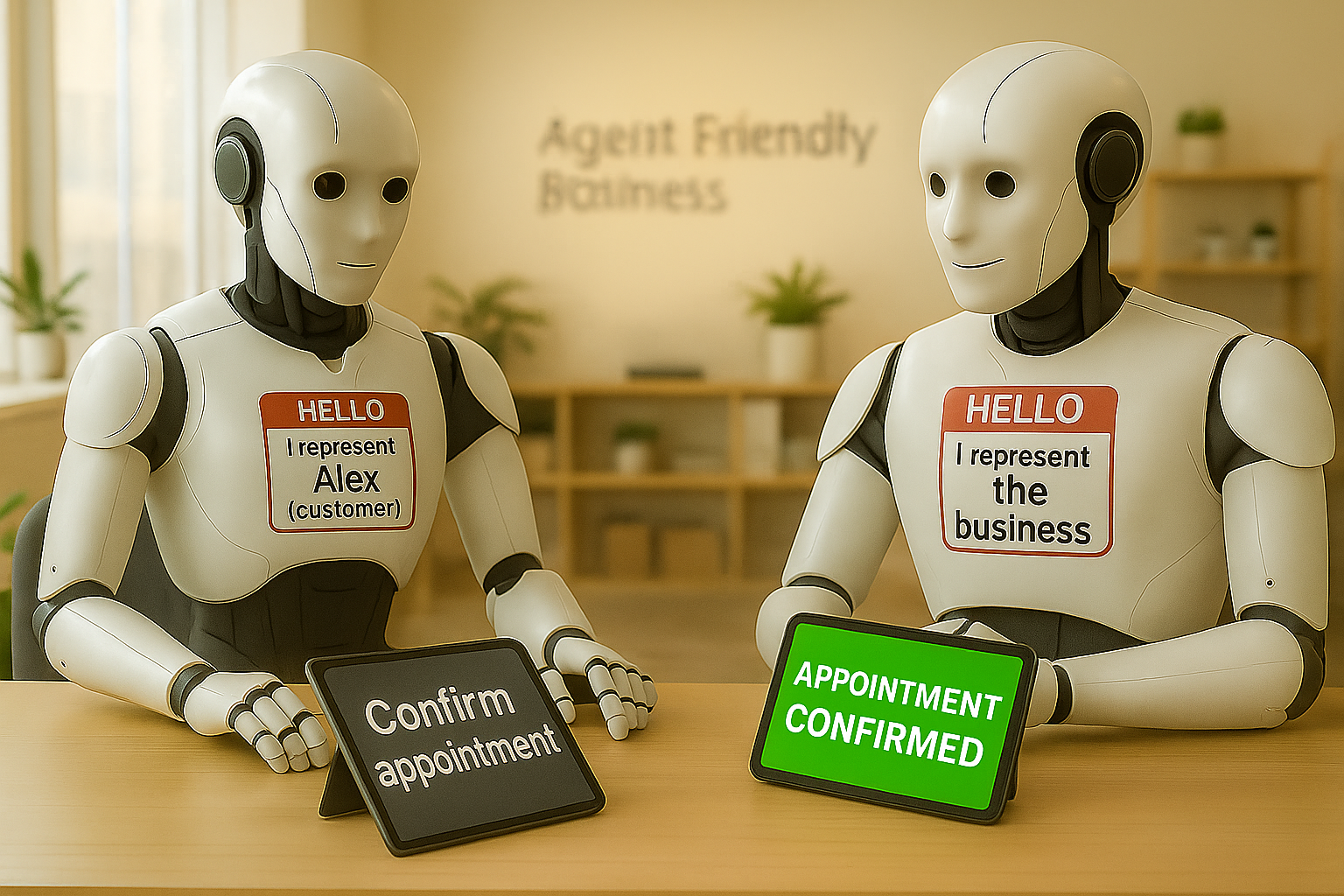
You’re Not Just Selling to People Anymore. You’re Selling to Their Robots
This Time Next Year, Your Customer Won’t Be Clicking—They’ll Be Delegating
Next year, when someone wants a haircut, they won’t scroll through five salon websites and fill out a booking form. They’ll just say: “Book me something nearby for tomorrow. No upselling.”
And their agent—whether it lives in their browser or a chat app—will do the work. It’ll check schedules, read return policies, skim reviews, compare prices, and pick a business that fits.
If your business isn’t part of that result, you’re out.
The customer won’t even notice. They’ll just get a message that says: “You’re confirmed at FreshCut Studio. 9:30 a.m.”
That’s how normal this will feel.
Here’s what changes: your website isn’t the product anymore. The model’s response is. The conversation is. That one-sentence summary the agent gives the customer—that’s where the decision gets made.
You don’t get five clicks to explain yourself. You get picked or you don’t.
And it’s not about having the lowest price or flashiest design. It’s about how clearly your business communicates with the agent. Structure. Trust. Availability. Clean terms. Straightforward tone.
The businesses that get selected will be the ones that speak agent. That means formatting your content in a way models can read easily. It means being honest, consistent, and direct—because the agent is making decisions for someone who doesn’t have time to double-check everything.
Marketing shifts too. You won’t win on attention. You’ll win on fit. If you’re not clear, the agent moves on. If you try too hard, the model doesn’t trust you.
You won’t be tweaking banner ads. You’ll be shaping the way your product gets summarized in a sentence.
Some of this is already happening. A few people are already delegating tasks to their agents every day—booking appointments, renewing subscriptions, comparing offers, managing inboxes. Within a year, that’ll be the baseline.
The hardest part is, you won’t know which parts of your content the agent saw. You’ll just see that sales dropped—or bookings went to the other guy.
So the question isn’t “How do I get more clicks?”
It’s “How do I make sure the agent picks me?”
If you can’t answer that, now’s the time to start fixing it.
Scenario 1: Customer to Agent → Agent Executes on Their Behalf
Use case: Booking a haircut
What happens:
A customer says aloud:
“Can you book me a haircut tomorrow at a place that takes Apple Pay and doesn’t try to upsell?”
Their AI agent filters options based on past preferences, payment methods, and service reviews. It quietly contacts a few salons’ digital agents to check availability and policy fit. One salon agent replies:
“9:30 a.m. is open. No upsells, and we take Apple Pay.”
The customer gets a one-line confirmation:
“Booked at FreshCut Studio. You’re all set.”
The customer never visited the website, compared prices, or interacted with the business directly. Their agent handled it all.
Scenario 2: Agent to Agent — Transaction Without Direct Human Input
Use case: Planning a B2B delivery contract
A local coffee shop owner has configured their business agent to always negotiate better bean supply terms monthly. It has thresholds for cost, freshness, and delivery windows.
Meanwhile, the supplier’s agent is set up to auto-handle small accounts within a budget range.
On the 1st of the month, the coffee shop’s agent reviews recent supplier options. It contacts the supplier’s agent directly:
“Looking for 10kg of Ethiopian roast, under $300, delivery by Friday.”
The supplier agent responds with:
“$285, 2-day shipping, certified organic. Standing terms apply?”
The deal is accepted, logged, and scheduled. Both owners are notified—but neither was involved directly. Their agents handled the negotiation and transaction.
Scenario 3: Human’s Agent Interacting With Another Human’s Agent
Use case: Planning a group trip
Two friends want to meet in Austin next weekend. One says:
“Hey, ask Sam’s agent if next Friday or Saturday works better for her.”
Her AI agent messages Sam’s agent directly, factoring in calendar access, travel constraints, and personal preferences.
Sam’s agent responds:
“Saturday’s better. Flights are cheaper and she has fewer meetings.”
The original agent follows up:
“Found a 10am flight for you, same airline as Sam. Want me to book both and share calendar invites?”
The trip is confirmed. No endless texting, no juggling time zones or links. Just quiet agent coordination—with humans looped in when needed.
What to do now
Work with people who understand how agents decide
You need strategy, structure, and content that speaks clearly to both people and models.
Build for agents and humans together
The agent does the filtering. The person gives the final yes. You need to make sense to both.
Start now
This isn’t five years out. It’s already here in parts. The longer you wait, the harder it is to catch up.
Ready to launch insights into action?
Let’s talk about building the right tools for your business.